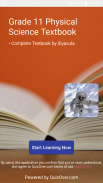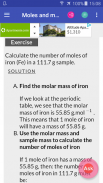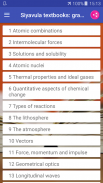






Grade 11 Physical Science Textbook, Test Bank

คำอธิบายของGrade 11 Physical Science Textbook, Test Bank
Siyavula Textbooks: Grade 11 Physical Science
* Complete Textbook by Siyavula
* Multiple Choices Questions (MCQ)
* Essay Questions Flash Cards
* Key-Terms Flash Cards
Powered by QuizOver.com the leading online quiz creator
https://www.quizover.com
Atomic combinations
Introduction
0.1 Atomic combinations
0.2 Why do atoms bond?
0.3 Energy and bonding
0.4 What happens when atoms bond?
1 Covalent bonding and lewis notation
2 Electronegativity and ionic bonding
3 Metallic bonding
4 Writing chemical formulae
5 Shapes of molecules
6 Oxidation numbers
7 Energy changes in chemical reactions
Intermolecular forces
Introduction and types of intermolecular forces
1 Understanding intermolecular forces
2 Liquids
Solutions and solubility
Introduction and key concepts
1 Solubility
Atomic nuclei
Introduction
1 Radioactivity and types of radiation
2 Sources of radiation
3 Half-life
4 Dangers and uses of radiation
5 Nuclear fission and fusion
Thermal properties and ideal gases
Boyle's law and charle's law
1 Ideal gas law and general gas equation
Quantitative aspects of chemical change
Moles and molar mass
1 Stoichiometry and composition
Types of reactions
Acid-base reactions
1 Redox reactions
2 Addition, elimination and substitution reactions
The lithosphere
Introduction
1 Mining and mineral processing
2 Energy resources
The atmosphere
Composition and structure
1 Greenhouse gases and global warming
Vectors
Introduction and key concepts
1 Mathematical properties
2 Adding and subtracting vectors
3 Components
Force, momentum and impulse
Introduction and key concepts
1 Newton's first law
2 Newton's second law
3 Lifts and rockets
4 Newton's third law
5 Different types of forces
6 Forces in equilibrium
7 Forces between masses
8 Momentum
9 Change in momentum
10 Impulse
11 Conservation of momentum
12 Physics in action
13 Torque and levers
14 Summary and exercises
Geometrical optics
Converging lenses
1 Diverging lenses
2 The human eye
3 Telescopes and microscopes
Longitudinal waves
Introduction and key concepts
1 Sound waves, seismic waves and graphs of motion
Sound
Introduction and key concepts
1 Applications
The physics of music
Standing waves in string instruments
1 Standing waves in wind instruments
2 Resonance and sound quality
Electrostatics
Coulomb's law
1 Electric fields around charges
2 Electrical potential energy
3 Capacitors
Electromagnetism
Magnetic field associated with a current
1 Current induced by a changing magnetic field
2 Transformers
3 Motion of a charged particle in a magnetic field
Electric circuits
Ohm's law
1 Resistance
2 Parallel and series networks
Electronic properties of matter
Conductors, insulators and semi-conductors
1 Intrinsic properties and doping
2 The p-n junction
ตำรา Siyavula: ระดับ 11 วิทยาศาสตร์กายภาพ
* ตำราให้เสร็จสมบูรณ์โดย Siyavula
* คำถามหลายทางเลือก (MCQ)
* คำถามเรียงความแฟลชการ์ด
* Key-ข้อตกลงแฟลชการ์ด
ขับเคลื่อนโดย QuizOver.com ผู้สร้างแบบทดสอบออนไลน์ชั้นนำ
https://www.quizover.com
การรวมกันของอะตอม
บทนำ
0.1 การรวมกันของอะตอม
0.2 ทำไมพันธบัตรอะตอม?
0.3 พลังงานและพันธะ
0.4 เกิดอะไรขึ้นเมื่ออะตอมพันธบัตร?
1 พันธะโควาเลนและสัญกรณ์ lewis
2 อิและพันธะไอออนิก
3 เมทัลลิพันธะ
4 การเขียนสูตรทางเคมี
5 รูปร่างของโมเลกุล
ตัวเลข 6 ออกซิเดชัน
7 การเปลี่ยนแปลงพลังงานในปฏิกิริยาเคมี
แรงระหว่างโมเลกุล
บทนำและประเภทของแรงระหว่างโมเลกุล
1 แรงระหว่างโมเลกุลเข้าใจ
2 ของเหลว
การแก้ปัญหาและการละลาย
บทนำและแนวคิดหลัก
1 ละลาย
นิวเคลียสของอะตอม
บทนำ
1 กัมมันตภาพรังสีและประเภทของการฉายรังสี
2 แหล่งที่มาของการฉายรังสี
3 ครึ่งชีวิต
4 อันตรายและการใช้ประโยชน์ของรังสี
5 นิวเคลียร์ฟิวชั่และฟิวชั่น
สมบัติทางความร้อนและก๊าซในอุดมคติ
กฎหมายของบอยล์และกฎหมาย Charle ของ
1 แก๊สอุดมคติกฎหมายและสมก๊าซทั่วไป
ด้านปริมาณการเปลี่ยนแปลงทางเคมี
ไฝและมวลโมเลกุล
1 ปริมาณสัมพันธ์และองค์ประกอบ
ประเภทของปฏิกิริยา
ปฏิกิริยาของกรดเบส
1 ปฏิกิริยารีดอกซ์
2 นอกจากนี้การกำจัดและเปลี่ยนตัวปฏิกิริยา
เปลือกโลก
บทนำ
1 การทำเหมืองแร่และการประมวลผลแร่
2 ทรัพยากรพลังงาน
บรรยากาศ
องค์ประกอบและโครงสร้าง
1 ก๊าซเรือนกระจกและภาวะโลกร้อน
เวกเตอร์
บทนำและแนวคิดหลัก
1 คุณสมบัติทางคณิตศาสตร์
2 การเพิ่มและการลบเวกเตอร์
3 องค์ประกอบ
กองทัพโมเมนตัมและแรงกระตุ้น
บทนำและแนวคิดหลัก
กฎข้อแรก 1 ของนิวตัน
กฎข้อที่สองของนิวตัน 2
3 ลิฟท์และจรวด
กฎข้อที่สามของนิวตัน 4
5 ชนิดที่แตกต่างกันของกองกำลัง
6 กองกำลังอยู่ในภาวะสมดุล
7 กองกำลังระหว่างมวลชน
8 โมเมนตัม
9 การเปลี่ยนแปลงโมเมนตัม
10 Impulse
11 การอนุรักษ์โมเมนตัม
12 ฟิสิกส์ในการดำเนินการ
13 แรงบิดและคันโยก
14 สรุปและการออกกำลังกาย
เลนส์เรขาคณิต
เลนส์บรรจบ
1 เลนส์ถ่าง
2 ตามนุษย์
3 กล้องโทรทรรศน์และกล้องจุลทรรศน์
คลื่นตามยาว
บทนำและแนวคิดหลัก
1 คลื่นเสียงคลื่นแผ่นดินไหวและกราฟของการเคลื่อนไหว
เสียง
บทนำและแนวคิดหลัก
1 การประยุกต์ใช้งาน
ฟิสิกส์ของเพลง
ยืนคลื่นในเครื่องสาย
1 คลื่นยืนในเครื่องมือลม
2 Resonance และคุณภาพเสียง
วิชาไฟฟ้าลถิตย์
กฎหมายของ Coulomb
1 สนามไฟฟ้ารอบค่าใช้จ่าย
2 ศักยภาพพลังงานไฟฟ้า
3 ตัวเก็บประจุ
แม่เหล็กไฟฟ้า
สนามแม่เหล็กที่เกี่ยวข้องกับปัจจุบัน
1 ปัจจุบันที่เกิดจากการเปลี่ยนแปลงสนามแม่เหล็ก
2 หม้อแปลง
3 การเคลื่อนไหวของอนุภาคในสนามแม่เหล็ก
วงจรไฟฟ้า
กฎของโอห์ม
1 ความต้านทาน
2 เครือข่ายแบบขนานและชุด
สมบัติทางอิเล็กทรอนิกส์ของเรื่อง
ตัวนำฉนวนและกึ่งตัวนำ
1 คุณสมบัติที่แท้จริงและยาสลบ
2 รอยต่อ p-n



























